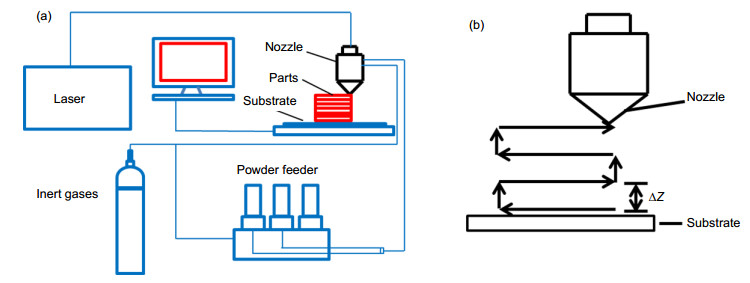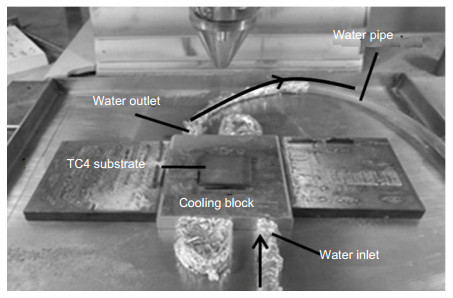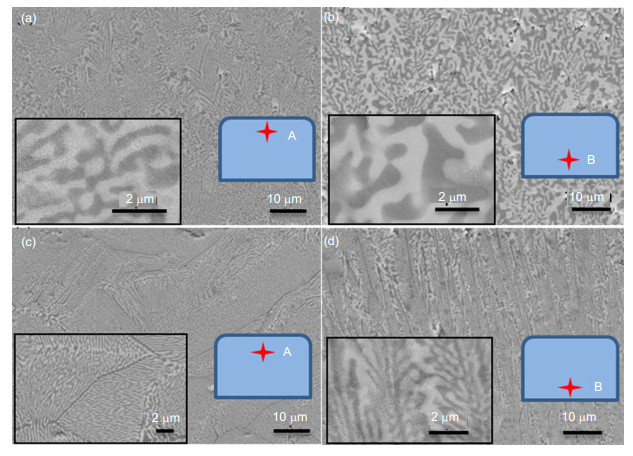Effect of constant temperature substrate on microstructure and hardness of Al2O3-based eutectic ceramics
-
摘要
Al2O3-YAG共晶陶瓷材料以其出色的高温强度、抗氧化性、高温结构稳定性成为航空航天领域高温合金的理想替代材料。本文采用激光近净成形技术,分别在普通基底、水冷恒温基底上进行了Al2O3-YAG共晶陶瓷薄壁件成形实验,得到了不同基底上成形的薄壁样件,比较了两者的微观组织及显微硬度差异。结果表明,采用普通基底成形的薄壁件微观组织呈三维网状结构,平均共晶间距为0.96 μm;采用水冷恒温基底后,薄壁顶部微观组织形貌呈晶团结构,薄壁底部呈枝状晶结构,微观组织逆热流方向生长特性明显,平均共晶间距减小至0.21 μm;和普通基底上成形的Al2O3-YAG共晶陶瓷薄壁件显微硬度相比,使用水冷恒温基底成形的Al2O3-YAG共晶陶瓷薄壁件硬度提高约10%。

-
关键词:
- 激光近净成形 /
- Al2O3-YAG共晶陶瓷 /
- 水冷恒温基底 /
- 微观组织 /
- 显微硬度
Abstract
Al2O3-YAG eutectic ceramic has become an ideal alternative to high-temperature alloys because of its excellent high temperature strength, high oxidation resistance and high temperature structural stability. The technology of laser engineered net shaping was used to prepare the Al2O3-YAG eutectic ceramic thin-wall samples. These samples were prepared on a common substrate and a water-cooled constant temperature substrate respectively. Their microstructure and microhardness were compared. The results show that the microstructure of thin-wall sample prepared on the common substrate is three-dimensional network structure with an average eutectic spacing of 0.96 μm. And the microstructure of top part of the sample prepared on the water-cooled constant temperature substrate is colony structure, while the microstructure of bottom part is dendrite structure which grows in the reverse direction of the heat flow. The average eutectic spacing of samples prepared on the water-cooled substrate has reduced to 0.21 μm. Compared with the microhardness of two kinds of thin-wall samples prepared on the different substrates, it is found that the microhardness of the thin–wall samples prepared on the water-cooled constant temperature substrate is increased by about 10%.
-
Overview

Al2O3-YAG eutectic ceramic has been considered as one of the most potential alternatives to current traditional superalloys applied in the aerospace field due to its extremely excellent high temperature mechanical properties, such as high temperature strength, oxidation resistance and high temperature structure stability. Al2O3-YAG eutectic ceramic thin-wall samples were prepared by laser engineered net shaping using Al2O3 and Y2O3 powders as raw materials. During the process of the laser engineered net shaping, the heat transfers to substrate and the heat accumulation is serious. According to this characteristic, a water-cooled constant temperature substrate was designed to change the temperature gradient and the cooling condition in the forming process. Al2O3-YAG eutectic ceramic thin-wall samples forming experiments were carried out on a common substrate and a water-cooled constant temperature substrate with the same laser power, scanning velocity, powder feeding rate and Z increment. The common substrate is TC4 substrate, while the water-cooled constant temperature substrate is composed of aluminum alloy cooling block, TC4 substrate, and plastic hose. The thermal plastic ensures the good contact between the TC4 substrate and aluminum alloy cooling block, and the heat accumulated on the TC4 substrate is rapidly dissipated through the aluminum alloy cooling block in which the constant temperature cooling water of 28 ℃ circulates. The Al2O3-YAG thin-wall samples prepared on different substrates were obtained, and their macro-morphology, microstructure and microhardness were compared. The results show that the water-cooled constant temperature substrate has a significant effect on the microstructure and eutectic spacing of Al2O3-YAG eutectic ceramic. The microstructure of thin-wall sample prepared on the common substrate is three-dimensional network structure with an average eutectic spacing of 0.96 μm. And the microstructure of top part of the sample prepared on the water-cooled constant temperature substrate is colony structure, while the microstructure of bottom part is dendrite structure which grows in the reverse direction of the heat flow. The average eutectic spacing of samples prepared on the water-cooled substrate has reduced to 0.21 μm. It is concluded that the morphological change of microstructures is mainly related to the degree of supercooling. The decrease of eutectic spacing is mainly due to the fact that the solidification rate is inversely proportional to the eutectic spacing. The applications of water-cooled constant temperature substrate can effectively improve the solidification rate, so the eutectic spacing decreases with the increase of the solidification rate. Comparing the microhardness of thin-wall samples prepared on the different substrates, the microhardness of the thin–wall sample prepared on the water-cooled constant temperature substrate is increased by about 10% due to the increase of the solidification rate and temperature gradient, the decrease of the eutectic spacing, grain refinement and the interaction between eutectic phase and cracks.
-

-
图 4 不同成形基底上成形的薄壁A、B区域SEM照片. (a)普通基底,A区域. (b)普通基底,B区域. (c)水冷恒温基底,A区域. (d)水冷恒温基底,B区域.
Figure 4. SEM patterns of different part of thin-wall sample under different substrates. (a) Common substrate, A region. (b) Common substrate, B region. (c) Water-cooled constant temperature substrate, A region. (d) Water-cooled constant temperature substrate, B region.
表 1 激光近净成形工艺参数.
Table 1. Process parameters of laser engineered net shaping.
Laser power P/W Scanning velocity V/(mm/min) Powder feeding rate Q/(g/min) Interlayer lifting capacity △Z/mm 350 340 1.65 0.21 -
参考文献
[1] Williams James C, Starke Edgar A. Progress in structural materials for aerospace systems[J]. Acta Materialia, 2003, 51(19): 5775-5799. doi: 10.1016/j.actamat.2003.08.023
[2] Feng Q, Picard Y N, Liu H, et al. Femtosecond laser micromachining of a single-crystal superalloy[J]. Scripta Aterialia, 2005, 53(5): 511-516.
[3] Waku Y, Nakagawa N, Wakamoto T, et al. A ductile ceramic eutectic composite with high strength at 1873 K[J]. Nature, 1997, 389(8): 49-52. https://www.wenkuxiazai.com/doc/d005d9848762caaedd33d495.html
[4] Sayir A. Directional solidification of eutectic ceramics[M]. Oxford: Oxford University Press, 1999: 1-7.
[5] Jose Y Pastor, Javier L Lorca, Alicea Salazar, et al. Mechanical properties of melt‐grown alumina–yttrium aluminum garnet eutectics up to 1900 K[J]. Journal of the American Ceramic Society, 2005, 88(6): 1488-1495. doi: 10.1111/jace.2005.88.issue-6
[6] Chen Guoqing, Fu Xuesong, Luo Junting, et al. Effect of cooling rate on the microstructure and mechanical properties of melt-grown Al2O3/YAG/ZrO2 eutectic ceramic[J]. Journal of the European Ceramic Society, 2012, 32(16): 4195-4204. doi: 10.1016/j.jeurceramsoc.2012.06.020
[7] Ma Weidan, Zhang Jun, Su Haijun, et al. Microstructure transformation from irregular eutectic to complex regular eutectic in directionally solidified Al2O3/GdAlO3/ZrO2 Ceramics by laser floating zone melting[J]. Journal of the European Ceramic Society, 2016, 36(6): 1447-1454. doi: 10.1016/j.jeurceramsoc.2015.12.023
[8] Yao Bin, Su Haijun, Zhang Jun, et al. Sintering densification and microstructure formation of bulk Al2O3/YAG eutectic ceramics by hot pressing based on fine eutectic structure[J]. Materials & Design, 2016, 92: 213-222.
[9] Nie Ying, Zhang Mingfu, Liu Yang, et al. Microstructure and mechanical properties of Al2O3/YAG eutectic ceramic grown by horizontal directional solidification method[J]. Journal of Alloys & Compounds, 2016, 657: 184-191. http://www.koreascience.or.kr/article/ArticleFullRecord.jsp?cn=SRMHB8_2004_v41n1_1
[10] Su Haijun, Zhang J, Liu L, et al. Rapid growth and formation mechanism of ultrafine structural oxide eutectic ceramics by laser direct forming[J]. Applied Physics Letters, 2011, 99(22): 221913-221913-3. doi: 10.1063/1.3664108
[11] Fazli R, Fazli M, Golestani-fard, et al. The Effects of raw materials particle size and salt type on formation of nano-cazro3 from molten salts[J]. Ceramics International, 2012, 38(7): 5775-5781. doi: 10.1016/j.ceramint.2012.04.024
[12] Rahman Fazli, Golestani-Fard F. The effects of processing parameters on molten salt synthesis of CaZrO3, nano-powders using oxide precursors[J]. Powder Technology, 2014, 257(5): 149-155. http://www.sciencedirect.com/science/article/pii/S0032591014001958
[13] Rahman Fazli, Golestani-Fard F. Influence of zirconia particle size on the synthesis of CaZrO3 nano-powders from na2co3–nacl molten eutectic salt[J]. Advanced Powder Technology, 2014, 25(5): 1547-1553. http://www.sciencedirect.com/science/article/pii/s092188311400137x
[14] 吴东江, 王江田, 牛方勇, 等.激光近净成形Al2O3–YAG复合陶瓷薄壁件微观组织与力学性能分析[J].硅酸盐学报, 2015, 43(6):741-746. http://www.opticsjournal.net/Journals/gdgc.htm
Wu Dongjiang, Wang Jiangtian, Niu Fangyong, et al. Microstructure and mechanical property of thin-wall Al2O3–YAG composite ceramics built by laser engineered net shaping[J]. Journal of the Chinese Ceramic Society, 2015, 43(6): 741-746. http://www.opticsjournal.net/Journals/gdgc.htm
[15] Suffner J, Sieger H, Hahn H, et al. Microstructure and mechanical properties of near-eutectic ZrO2–60wt.% Al2O3 produced by quenched plasma spraying [J]. Materials Science and Engineering: A, 2009, 506(1): 180-186. http://www.sciencedirect.com/science/article/pii/S0921509308013269
[16] Zhao Zhongmin, Zhang Long, Zhang Shiyue, et al. Microstructures and mechanical properties of large-scale Al2O3/ZrO2(Y2O3) self-growing ceramic plates prepared by combustion synthesis under high gravity[C]//International Conference on Smart Materials and Nanotechnology in Engineering. International Society for Optics and Photonics, 2007: 64235B-64235B-8.
[17] Su Haijun, Zhang Jun, Cui Chunjuan, et al. Rapid solidification behaviour of Al2O3/Y3Al5O12(YAG) binary eutectic ceramic in situ composites[J]. Materials Science and Engineering: A, 2008, 479(1): 380-388. http://www.sciencedirect.com/science/article/pii/S0921509307013937
[18] Yao Wenlong, Liu Jing, Troy B Holland, et al. Grain size dependence of fracture toughness for fine grained alumina[J]. Scripta Materialia, 2011, 65(2): 143-146. doi: 10.1016/j.scriptamat.2011.03.032
[19] 苗佩, 牛方勇, 马广义, 等.沉积效率对激光近净成形316L不锈钢组织及性能的影响[J].光电工程, 2017, 44(4): 410-417. http://www.oejournal.org/J/OEE/Article/Details/A170829000010/CN
Miao Pei, Niu Fangyong, Ma Guangyi, et al. Effect of deposition efficiency on microstructure and property of 316L stainless steel fabricated by laser engineered net shaping[J]. Opto-Electronic Engineering, 2017, 44(4): 410-417. http://www.oejournal.org/J/OEE/Article/Details/A170829000010/CN
-
访问统计


 E-mail Alert
E-mail Alert RSS
RSS

 下载:
下载:







